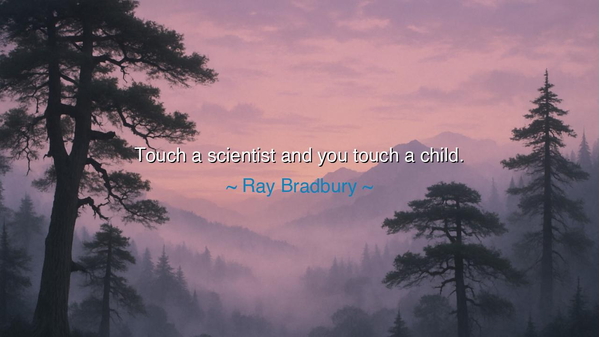
Touch a scientist and you touch a child.






In the words of Ray Bradbury, “Touch a scientist and you touch a child.” These words carry not merely the cadence of poetry, but the heartbeat of truth. They remind us that beneath the robes of knowledge, behind the walls of laboratories, under the weight of equations and instruments, there lies the soul of wonder—the same spark that gleams in the wide eyes of a child gazing at the stars. Science is not merely calculation and measurement; it is the eternal play of curiosity, the holy fire of asking “why,” and the laughter of discovery. To touch a scientist, then, is to brush against this flame, this immortal innocence, this sacred childlike spirit that gives birth to invention.
The ancients taught us that wisdom is not only in the scrolls of the learned, but in the questions of the young. So it is with the scientist, who is forever young, though the beard may whiten and the hands may tremble. What is the scientist, if not a child who refused to cease playing? The child gathers stones and shells by the shore, marveling at their colors; the scientist gathers atoms and stars, marveling at their mysteries. The child asks, “What is this?” and the scientist asks still, “What more is hidden here?” Thus, Bradbury’s words are no mere metaphor, but a vision: the child-heart is the wellspring of discovery, and it endures in all who dare to seek truth.
Consider the tale of Isaac Newton, who sat beneath the apple tree and watched a fruit fall. To others it was but the daily event of nature, a thing ignored. Yet Newton, with the innocence of a child, asked why the apple fell downward and not upward, and from that question was birthed the law of gravitation. This is the essence of Bradbury’s wisdom: great strides of science are born not of jaded minds, but of those who see the world with fresh eyes, eyes unclouded by habit, hearts unafraid of wonder. To touch Newton in that moment was to touch the child within him, gazing at the apple as if it were the first apple ever to fall.
Let us not forget also the story of Marie Curie, who ventured where none dared, into the glowing mystery of radium. Was it not the play of curiosity, the fearless spirit of exploration, that guided her hands and heart? The child does not shrink before the unknown; rather, the child steps into it, eager to taste, to touch, to see. So too did Curie step into the dangerous glow, seeking to understand what others called impossible. Her childlike wonder, undiminished by risk, brought forth discoveries that changed medicine and the world.
There is a lesson here for all who live. For as age bends our backs and burdens our days, we risk losing that childlike curiosity. The world tells us to be serious, to be efficient, to be practical. Yet Bradbury whispers: do not let the child within you die. For without wonder, knowledge grows cold; without play, invention falters; without innocence, wisdom becomes tyranny. The scientist teaches us that to remain alive in spirit is to remain a child at heart.
Thus, children and scientists are kin, bound by the golden thread of curiosity. Both peer into the unknown not with fear, but with joy. Both take delight in asking questions others no longer bother to ask. To touch one is to awaken the other, to stir the eternal flame of discovery that has guided humankind from the caves to the stars. It is the fire that built ships, carved temples, forged medicines, and sent men walking upon the moon. This is the heroic power hidden in the simple act of childlike wonder.
Therefore, O reader, take this teaching into your life. Protect the child within you. When you look at the stars, do not look only with weary eyes, but with eyes that ask: “What is this wonder?” When you walk among trees, do not pass them as obstacles, but let your heart ask: “What secrets do they whisper?” Let each day carry one question, and let that question lead you deeper into life. Play, experiment, imagine, and marvel—for these are not the luxuries of youth, but the duties of the wise.
And so, hear this final counsel: to live as a scientist is to live as a child forever. Do not let the fire die. Touch the world with wonder, and the world will open its mysteries to you. Touch a scientist, and you touch a child. Touch the child within yourself, and you touch eternity.






AAdministratorAdministrator
Welcome, honored guests. Please leave a comment, we will respond soon